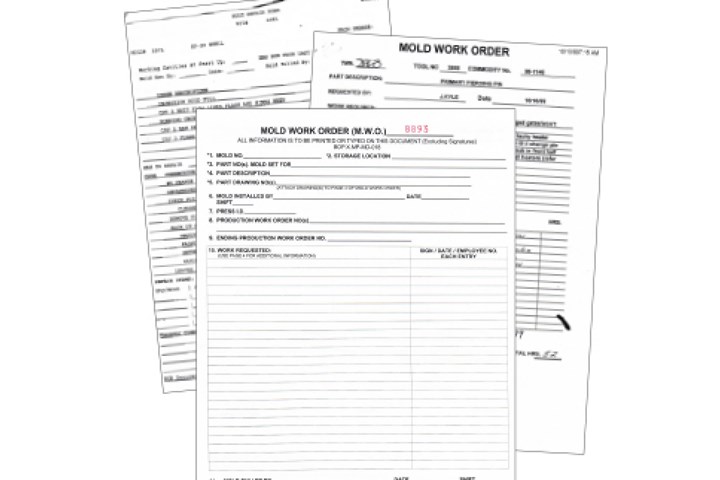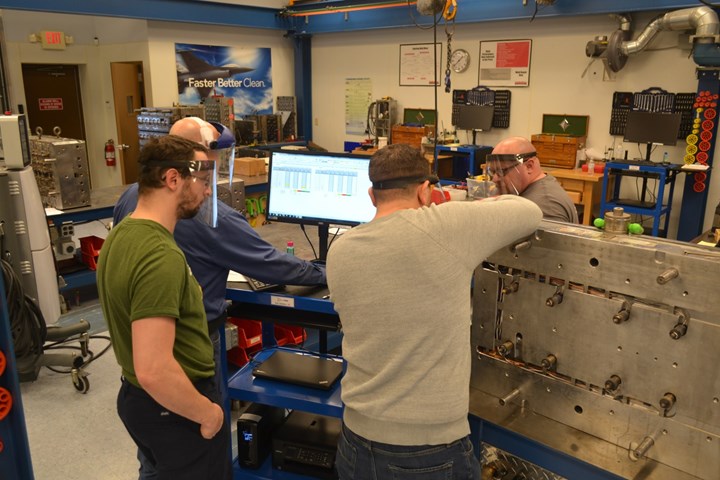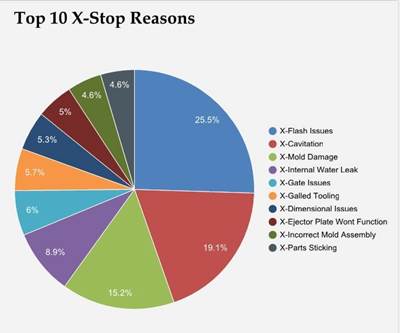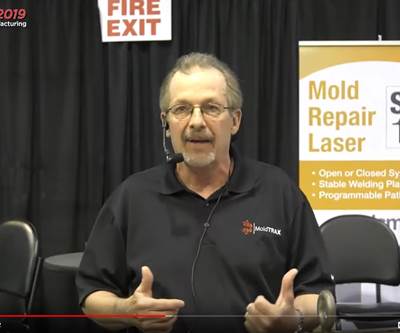What Is Scientific Maintenance? Part 1
Part one of this three-part series explains how to create a scientific maintenance plan based on a toolroom’s current data collection and usage.

These various traditional types of work order forms all collect critical data the same way—through journal type entries. Photo Credit: MoldTrax LLC
Scientific means using data to form ideas, and to develop and support theories and facts. It is not an adjective that one typically associates with mold maintenance because the accurate and standard language for defects, probable causes, corrective and preventative actions, tooling replaced and more, is seldom used in repair shops. Instead, toolrooms rely on subjective journal entries and notes on a work order form. This type of data is not measurable unless the shop uses many tedious man-hours scouring every work order, hoping to recognize and count such things as frequencies, costs, etc.
Unfortunately, the size of a company is not necessarily a precursor to its culture and level of documentation skills. Even large corporations can be archaic in their maintenance documentation practices that leave them woefully susceptible to high tooling and labor costs, unscheduled mold stops and part quality issues.
Simple Signals Are Not Enough
One method molders use relies on collecting cycle counts and other start/stop electronic data signals from a press, a process monitoring system, or electronic cycle counters. These signals may be used to create alerts about molds when something is out of a set range.
Variables like processing parameters, cycle times and preventative maintenance (PM) frequencies are helpful to know, but not nearly enough to accurately notice trends and patterns, track defects, document tooling and corrective actions, or to create smart maintenance plans for every mold that hits a bench.
Mold maintenance data requirements are vastly different, based on several factors.
Today, everyone agrees that data-driven decisions must be more prominent on the repair side of molding. However, confusion is evident when toolroom technicians cannot explain the exact electronic signals to digitize to have their molds run better and more reliably. Over the years, the cultural development of repair shops has led most to focus on fire-fighting issues versus prevention by turning historical maintenance records into preventable actionable items.
To better understand how repair shops can move to a more scientific, 4.0-type platform, we must first take a hard look at our own maintenance culture and legacy shop practices to realistically map out a customized plan for a more scientific approach, based on what data is currently being collected and how it is being used. There are different “skill levels” of data collection and usage, and it is crucial to not overwhelm the shop with a ton of new forms right out of the gate.
How Much Data Do You Really Need?
Mold maintenance data requirements are vastly different, based on several factors. The first factor is product type and mold cavitation/complexity. For example, two- to four-cavity molds producing simple parts with generous flash and other part specifications typically do not have dozens of close-fitting components with multiple parting lines and are easier to track when compared to complex, higher cavitation molds (16 and above) that are producing close-tolerance medical or electrical parts.
When molds come in for repair, the volume of information collected about replacements and repairs is much lower. Often, a handwritten note or logbook accompanies the mold but only keeps the most basic information. That said, even simple molds can suffer long-term and repetitive issues that require more accurate, measurable information to identify a root cause or employ more PM techniques.
Another factor affecting the volume of data is mold pull pace (MPP). MPP is the number of molds stopped or pulled over 24 hours for maintenance or repair. Tool rooms performing five or more mold changes a day, along with stopping and pulling five or more molds for part quality issues or mold function problems, will have an increased volume of data to enter into a system. So, to combat “data entry overload,” it needs to be easy—as in choosing terms from drop-down menus versus a lot of typing, or users will neglect the system.
Four Levels of Maintenance Data Collection
Here are the four cultural levels of typical maintenance data collection and usage across many tool rooms operating as proprietary, custom, or a combination of molding operations.
Level 1: Notes or Nothing
This level of data collection has no information collected during the production run or subsequent maintenance procedures; technicians troubleshoot or repair mold or part issues based solely on memory and shop experience. Sometimes, technicians struggle to find a mold because there are no standard mold numbers assigned, and the processing person does not take a last shot or defect sample to find and repair potential issues proactively.
Level 2: Formal Log-Book System, Colored Tags, Work Order and Excel Spreadsheets
I lump these four together because technicians use any of these methods to write down everything they think is relevant. These four options are popular with most companies because they are easy to complete. Information ranges from a novel-type entry to a simple “fixed it” comment. These methods work for toolrooms running low-cavitation molds with generous part specifications, allowable flash and a low MPP (e.g., two or three molds per week).
With these manual methods, process supervisors or molding personnel communicate the mold issue and required work to the toolroom through mold performance “stories” in “comment” fields or enter into a logbook that is typically kept on the molding floor. The processor or repair technician enters his or her story into the logbook as issues occur during production and repair. Some techs enter these stories on colored (green, yellow, or red) tags, but the data collected is similar.
Excel spreadsheets are a step in the right direction towards scientific maintenance, allowing the technician to collect data in a more measurable form. For example, the use of standard terms in columns and rows allows sorting and filtering, from which the technician can count frequencies and identify positional patterns and trends that are critical when troubleshooting or performing root cause analysis.
However, the accuracy of the input goes a long way in determining a spreadsheet’s usefulness. For example, if the sheet does not use drop-down fields for consistent entries, the accuracy of the data relies on typed-in words. Capitalization, varied spelling, hyphenation, or spacing will create additional lines of entries, which yields confusing data. The team must enforce and monitor standard terminology before too many garbage entries are input.

Level 3: Access Databases
Access is a popular data management system from Microsoft that combines a database engine with a graphical user interface along with software-development tools. It is a popular system for even IT novices for maintenance databases and asset management.
Like Excel, the system’s usefulness is dependent upon the developer’s skill and the user’s diligence. In the right hands, Access is a powerful database system and can create reports and graphs that are extremely valuable in identifying high-cost issues and poorly-running molds.
The downside is that data can easily be corrupted by the user, resulting in locked-up systems and other problems whenever the user or Microsoft upgrades the system. In Access, there are continuous service patches a user must apply for everything to function correctly, and with many companies moving to third-party IT support, this can be problematic.
Level 4: CMMS and ERP (Local and Global)
Many companies are moving to computerized maintenance management systems (CMMS) that centralizes maintenance information. CMMS, unlike the more considerable enterprise resource planning (ERP) systems, lean towards a focus of asset availability and uptime. Most can automate work orders and workflows, schedule needed PMs, manage tooling inventory and provide some reports about those tasks.
The core value of a CMMS is how its work order management functions. With most CMMS systems, the desire is for companies to be able to use the same work order format to track plant maintenance issues such as vehicles, fork-trucks, water systems, electric motors, assembly lines, or any mechanical asset. The only way to achieve this is to provide the user with a generic comment field on the work order form to enter asset performance or maintenance information.
However, a generic work order system creates opportunities for missing or incorrect information. Users are still required to write “stories” in the comment fields to understand what happened, but without standard terms pulled from drop-down boxes, the data is ambiguous, incomplete, or illegible.
Collecting the proper electronic signals from a press, a counter, or any number of sensors placed in or on a mold and then digitized in a platform to improve connectivity between employees, departments and plant locations benefit mold maintenance. However, the “core” data required by repair technicians and those who manage repair shops will not be in the form of an electronic signal.
Next month I will explain the specific data that tool rooms must collect, analyze and use to truly advance to a scientific maintenance culture where you can measure real data and drive decisions. I will also include a Documentation Capabilities Checksheet for technicians to fill out to determine how they measure up against other shops.
Related Content
Outlook for Automation in 2024
I want to share an article I found that discusses the reasons manufacturers should adopt automation in 2024 as a strategic response to global uncertainties, reshoring requirements, labor shortages and the pursuit of increased productivity.
Read MoreFive Strategies to Make Automation Affordable
Mold manufacturers can maintain their competitive edge by making smart capital investments in times of crisis.
Read MoreMMT Chats: Predictable Manufacturing and Incremental Gains Can Transform Moldmaking
MoldMaking Technology Editorial Director Christina Fuges catches up with the president of Eden Tool and Eden Manufacturing, Dave Tomic. We talk about predictable performance in moldmaking and the value of small incremental gains in an organization versus big change via disruptive technology. This episode is brought to you by ISCAR with New Ideas for Machining Intelligently.
Read MoreEnhancing Global Manufacturing Visibility: How Digital Moulds Solved SKF's Data Accessibility Challenges
SKF improved global manufacturing visibility and data accessibility through Digital Moulds' cloud-based monitoring system, enhancing real-time machine status tracking.
Read MoreRead Next
PODCAST: Educators in Mold Maintenance
The key to successfully educating mold builders and molders about mold maintenance is to listen twice as much as you talk for the improvement in finding problems and creating solutions.
Read MoreHow Will Industry 4.0 Impact Mold Maintenance?
Many toolrooms want to replace manual entries with electronic data when creating maintenance work orders and providing past historical issues, corrective actions and the effectiveness level of resolutions, but technicians require more information than electronic signals can provide to prove a return on investment of their time.
Read MoreVIDEO: Elements of a New Age Repair Shop
Just as important as creating a solid maintenance plan for molds, is the shop in which the repair takes place. In this Toolroom Live Demo, Steve Johnson of MoldTrax presents an overview of a successful toolroom setup that includes a variety of essential bench and cleaning equipment on the market today.
Read More





















